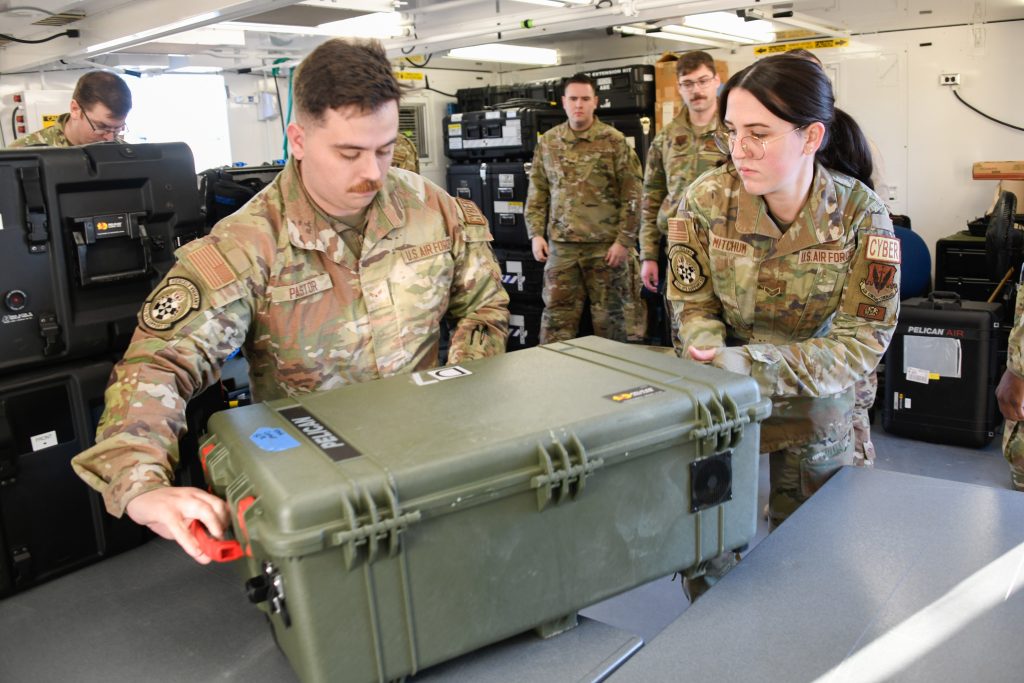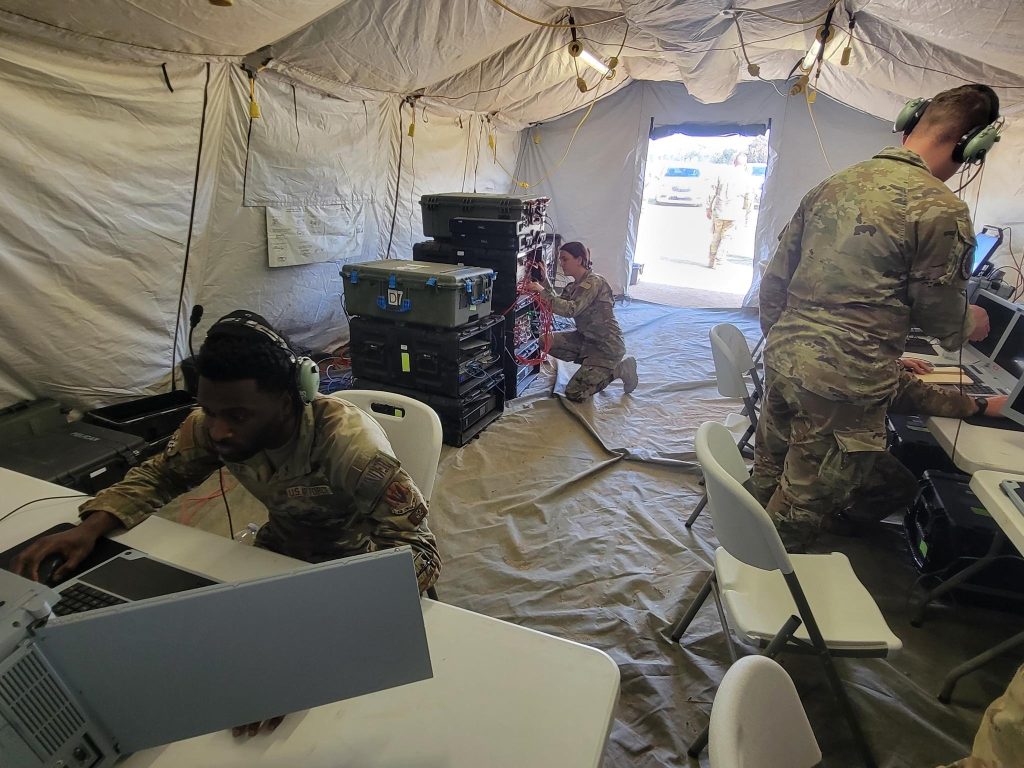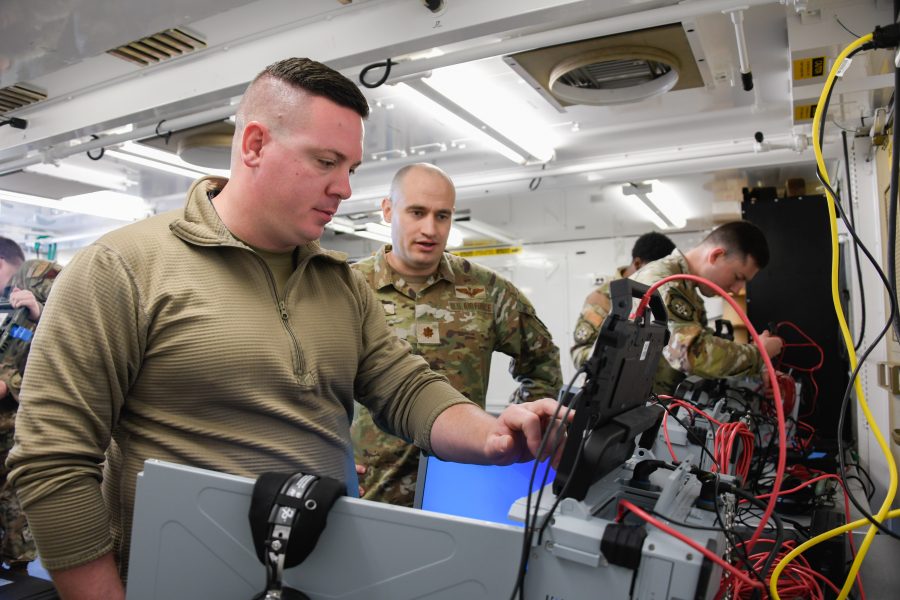TINKER AIR FORCE BASE, Okla.—In a potential future conflict in the Pacific, the Air Force wants to operate as leanly as possible from far-flung expeditionary airfields. So the Air Force is trying to squeeze a command-and-control package that used to require six C-17s down to something small enough to fit on a single C-130.
The new Tactical Operations Center-Light (TOC-L) is among the first fruits of the Air Force’s ambitious drive to modernize the management enterprise. The system is “the basic building block for where we’re going for infrastructure for C2,” said Brig. Gen. Luke C.G. Cropsey, director of all things command, control, communications, and battle management, in February. The Air Force has already fielded 16 prototype kits.
“We’re giving the operator an opportunity to go muck around with it and figure out what works, what doesn’t work, what we need to modify,” he said then.
It has been a busy several months for the Airmen of the 752nd Operational Support Squadron here at Tinker. The unit is Air Combat Command’s “pathfinder” testing out the new battle management kit.
From major exercises like Project Convergence and Bamboo Eagle to training in an abandoned neighborhood just off base, Airmen have been doing just that, said Maj. Cody Martin, 752nd assistant director of operations, in an interview with Air & Space Forces Magazine.
“We practice packing it up into a truck, moving it, taking it out of the truck, documenting, like, ‘Hey, we packed it, this way works well.’ Or, ‘Hey, when we pack it this way, this thing doesn’t work correctly. It broke,’” Martin said. “It’s pathfinding, from a sense of, yes, we want to find the things that work … but you also [discover] the negative things too. So you find like, this specific piece is going to be an issue for everyone that’s going to use this kit.”
Airmen are taking note of the time, effort, and space it takes to move at each major exercise. That includes “the operator workstations, the radio sets, the data link terminals, how the equipment is packed up and transported and moved around the different theaters,” said squadron commander Lt. Col. Brian Hamilton. They also have to make sure the system does “the things that we’re used to doing from a battle management perspective, from what an air tasking order would have us do throughout a theater to actually control aircraft and manage the airspace.”
The Air Force has for years used its Control and Reporting Centers (CRC)—which include the AN/TPS-75 radar, AN/TYQ-23 operations module, communications terminals, and more. A full CRC unit includes roughly 350 personnel, 170 vehicles, 22 power generators, and more. It is a mobile capability that can forward deploy—but it takes a major effort.
“Legacy is heavy. … Just to do battle management, command and control on the legacy side, we’re looking at upwards of six C-17 just to get folks out somewhere,” said Hamilton.

Meanwhile, TOC-L is, well, light.
“Basically TOC-Light is roughly 4,500 pounds of equipment that approximately fits into 35 transit cases, … on a single … pallet position,” Hamilton said. It’s ideally suited to the Air Force’s Agile Combat Employment concept (ACE).
“This kit is the Air Force’s answer to ACE-ing ground battle management,” said Martin. “If a battle management function is needed in an area, we’re not last in line in the order because we’re so big. We’re pretty easy to take care of, and therefore pretty easy to get out there quickly.”
TOC-L uses Cloud-Based Command and Control (CBC2), fusing data from 750 radar feeds into a single interface, and using artificial intelligence to help battle managers prioritize and execute a path of action.
“That software that is a part of those kits, is the biggest advancement,” Martin said. “Yes, the footprint is small, but a lot of what that kit can do internally is better than the legacy gear as well.”
The system will be all the more crucial as the Air Force phases out its E-3 fleet and awaits new E-7 Wedgetail jets to come.
Col. James Combs, deputy commander of the 552nd Air Control Wing, noted that air- and ground-based battle management are meant to complement each other, each providing its own benefits. But he acknowledged that “we’re naturally just going to lean on whatever tools we can to get the mission done.”

“We’re instilling in our Airmen more of that expeditionary mindset,” Combs said. “The CRC may not have as constant an ability to talk to every airplane out there because of the distance, because of the ranges they’re working with, or because the line of sight, whatever the case may be, but we’ve developed tactics, techniques and procedures to mitigate that.”
TOC-L will be a big part of that, Combs suggested.
“I can get the people and the basic kit over there, set up, start making connections, and begin to give them some level of command and control, and then that is scalable,” he said.
Figuring out the intricacies of what that looks like is still a work in progress.
“What they’re doing is literally writing the book,” Combs said of the 752nd. “They are writing the task lists of how best to use this. They’re working with industry to go, ‘We need it to do this. I want it to do that, if only you could make it fit into this.’ They’ve got that responsiveness. And so they’re literally innovating the best way that we can use this.”
Next up is “Major Release 2” for TOC-L, coming in the next year or so, said Hamilton. In the meantime, Airmen are pushing the system as hard as they can.
“When we step out the door, identifying hiccups isn’t a failure,” Martin said. “It’s really kind of the opposite. That’s the whole point.”
Editor’s Note: This story was updated Sept. 4 to clarify the source of some quotes as 752nd OSS commander Lt. Col. Brian Hamilton.
